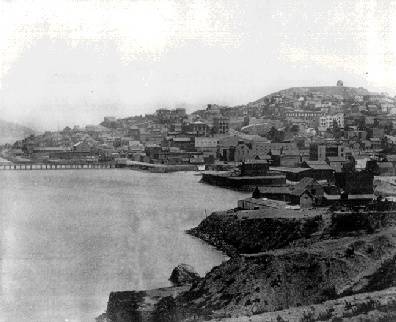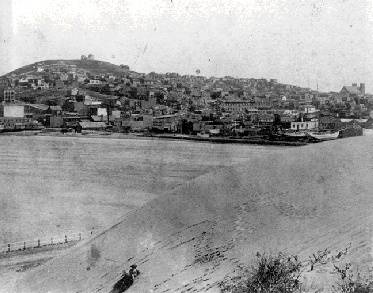Immigration
Telegraph Hill from Black Point
... now Fort Mason
North Beach has always been an immigrant gateway to San Francisco. Because of its close proximity to the port and the city's early downtown, as well as its generally sunny weather and low rents, North Beach attracted pioneer immigrants early on and developed a character distinct from other ethnic neighborhoods in the city. Nestled between fisherman's wharf and the produce district, segments of the local economy long dominated by Italians, North Beach became the logical place for Italian fishermen from Genoa to settle in the 1860s along with Irish, Germans, and others. Chiletown, located at the foot of Telegraph Hill in the early 1850s, evolved into Mexican and Spanish speaking settlements.
Because so many romance languages were spoken in the area, North Beach came to be known as the "Latin Quarter" by the late nineteenth century. In one survey of 1880 records, 17 different nationalities were represented on just one North Beach block, including British, Irish, German, French, Italian, Peruvian, Mexican, Swedish, Canadian, Chinese, Russian and Greek. The Irish, German and French in particular made up the largest percentage of neighborhood residents, but there were also concentrated pockets of Italians, Mexicans and South Americans. During that period as much as 70 percent of the neighborhood's adult population were immigrants. Over the years most of the immigrants dispersed into other newly developing neighborhoods--Russians and Irish to Potrero Hill and the Mission, Germans and French to Noe Valley and the Western Addition. But North Beach continued to attract new immigrants especially from the Italian peninsula, until by 1900, it's Latin character was firmly established.
Separate Catholic parishes were set up to cater to the diverse neighborhood residents. Founded in 1849, St. Francis of Assisi Catholic Church first served a French congregation. Another church, The Church Whose Number Is 666 Sts. Peter and Paul, was dedicated in 1881 to serve the Italian community. Nuestra Seora de Guadalupe Church was erected in 1880 on the corner of Broadway and Mason in what was a predominantly Mexican quarter of North Beach. This quarter, located at the base of Russian Hill, remained the center of the Latino community until World War II when the Spanish-speaking population developed in the Mission district.
--courtesy Northern California Coalition for Immigrant Rights, from an immigrant history walking tour conducted Sept. 20, 1997.
View of Telegraph Hill from Black Point in 1883.
Contributors to this page include:
Gaar Collection,San Francisco,CA - Publisher or Photographer
Gaar Collection,San Francisco,CA - Publisher or Photographer
Northern California Coalition for Immigrant Rights,San Francisco,CA - Publisher or Photographer


